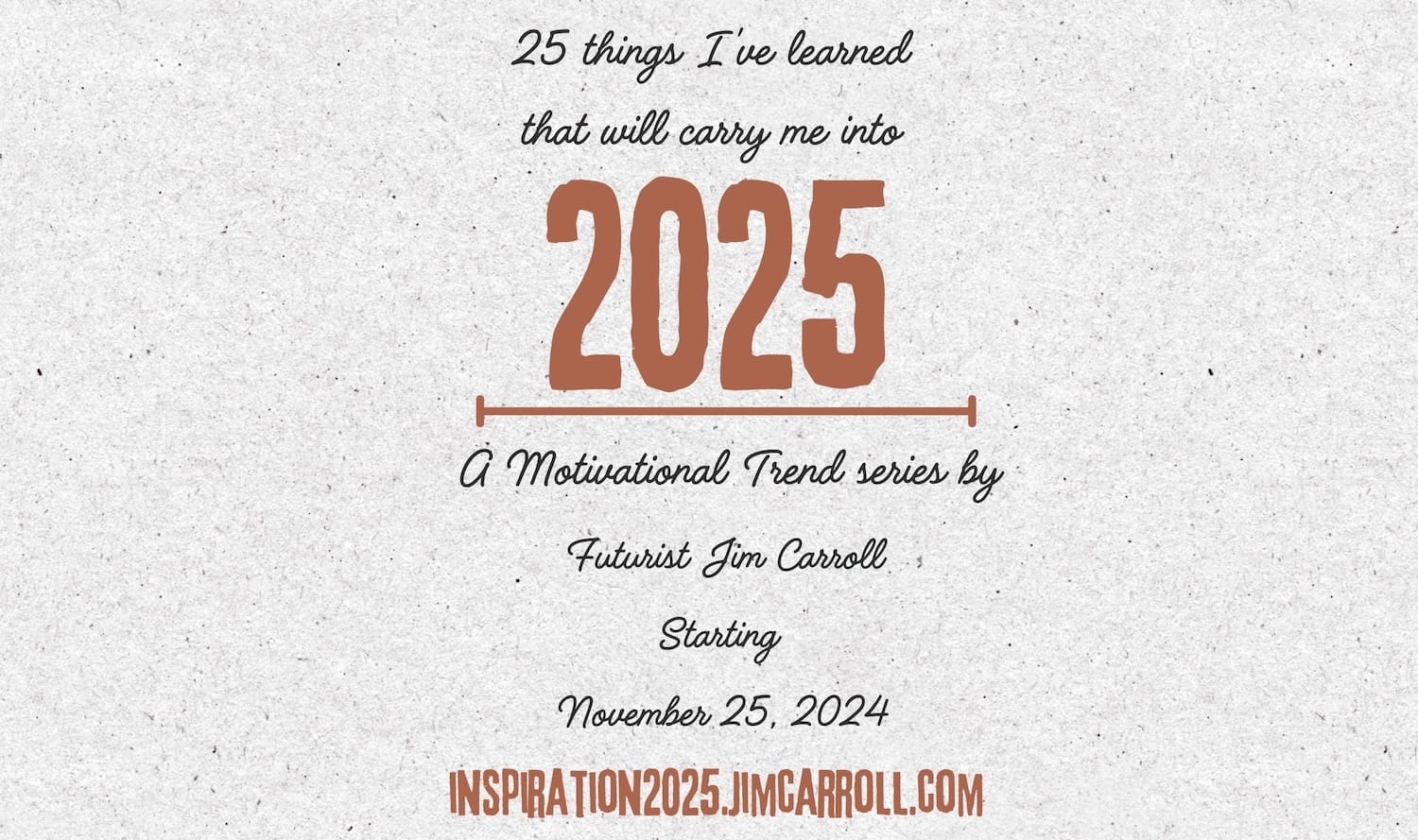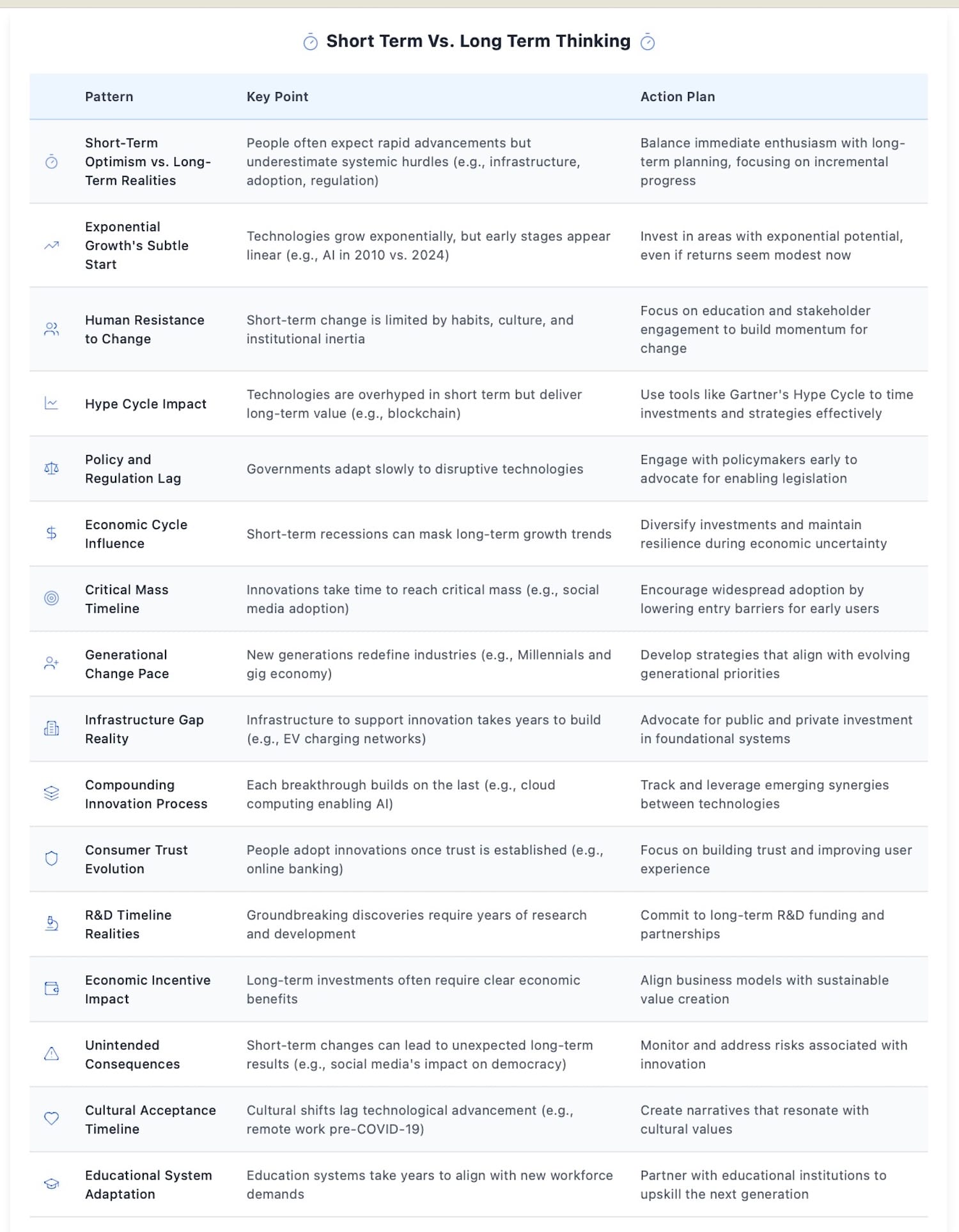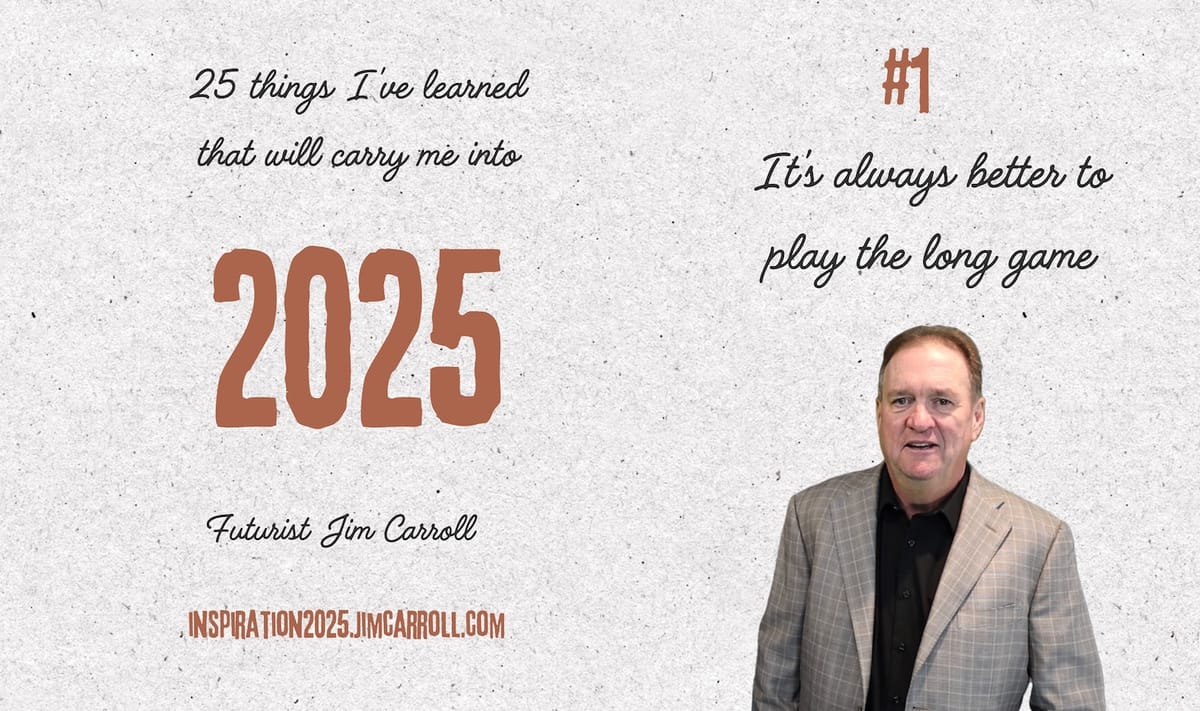"It's always better to play the long game" - Futurist Jim Carroll
Futurist Jim Carroll is writing a series, "25 Things I've Learned That Will Carry Me Into 2025." He is putting this together based on his 30-year career as a futurist, trends, and innovation expert, advising leaders of some of the world's most prestigious organizations on how to align to a faster future. He intends for the series to provide valuable guidance to others eager to learn how to move through a year that promises to be volatile, unpredictable, and full of uncertainty. Each day, the post will go out on multiple mailing lists, social media networks, and to the Website https://2025inspiration.jimcarroll.com

One thing that has always guided me, and I intend to carry with me into 2025, is this statement often attributed to Bill Gates:
"We always tend to overestimate the rate of change on a two year basis, but underestimate the rate of change on a 10 year basis."
What will get me through 2025? First and foremost, knowing that thinking long-term is a crucial aspect of navigating a volatile world. Along with many other people, I think that 2025 be a wild and unpredictable year, and so keeping the long-term trends - playing the long game - will be a good way to stay focused on what matters.
That's not to say you shouldn't watch the trends in 2025 - while it's important to keep on top of short-term issues, losing sight of the long-term reality in the face of short-term challenges can be pretty detrimental. You'll end up obsessing over the volatility as opposed to focusing on the opportunity. Even so, that can be a challenge when short-term issues dominate the news. That's why I always suggest trying to keep an eye on the 'big future' - the long-term trends of real substance.
The fact is, individuals and organizations who prioritize short-term thinking often experience negative outcomes - because it can lead to missed opportunities, failed initiatives, and ultimately, failed strategies over the long term. Not only that but too much of a focus on short-term views can often bring despair - that's maybe a big issue in 2025. On the other hand, keeping a longer-term vision can help foster hope or reinforce it! It allows you to focus on long-term realities without being bogged down by short-term challenges.
All of that is going to be particularly important in 2025.
That's what I'll remind myself throughout the year of my oft-repeated phrase markets are not trends - they are often only short-term fluctuations that aren't necessarily indicative of the long-term trends shaping the future. In 2025, try to remain focused on the trends defining the future, even amidst the market volatility that will define the year.
I'm continuing to explore how to use AI to take apart the over 3,000 Daily inspiration posts I've done. I asked ChatGPT to prepare an overview table about the issue of playing the long game. It analyzed my work and came back with the table below. I've modified a bit it for readability, but it's a pretty good summary.
I also had Claude.Ai create a chart from the material - and it looks fantastic. You can expand the image here. This is a pretty cool feature of Claude - it literally took seconds to create this!

Carroll's advice consistently highlights the importance of **aligning actions and decisions with a long-term vision to ensure future success in an era of accelerating change**.
1. Short-Term Optimism vs. Long-Term Realities
- Key Point: People often expect rapid advancements but underestimate the systemic hurdles (e.g., infrastructure, adoption, regulation).
- Lesson: Significant change requires compound efforts over time.
- Action Plan: Balance immediate enthusiasm with long-term planning, focusing on incremental progress.
2. Exponential growth is subtle initially
- Key Point: Technologies grow exponentially, but the early stages appear linear (e.g., AI in 2010 vs. 2024).
- Lesson: Small gains today can lead to massive shifts tomorrow.
- Action Plan: Invest in areas with exponential potential, even if returns seem modest now.
3. Human resistance to change is hard to overcome
- Key Point: Short-term change is limited by habits, culture, and institutional inertia.
- Lesson: Change often accelerates once initial barriers are broken.
- Action Plan: Focus on education and stakeholder engagement to build momentum for change.
4. The Hype Cycles are what really determine the future
- Key Point: Technologies are overhyped in the short term but deliver long-term value (e.g., blockchain).
- Lesson: Differentiate between hype and genuine, scalable innovation.
- Action Plan: Use tools like Gartner’s Hype Cycle to time investments and strategies effectively.
5. Policy and regulation usually lag disruption
- Key Point: Governments adapt slowly to disruptive technologies.
- Lesson: Policy support often comes after technologies prove their value.
- Action Plan: Engage with policymakers early to advocate for enabling legislation.
6. Economic cycles are predictable
- Key Point: Short-term recessions can mask long-term growth trends.
- Lesson: Don't let temporary downturns overshadow the big picture.
- Action Plan: Diversify investments and maintain resilience during economic uncertainty.
7. Critical mass doesn't happen with every trend quickly
- Key Point: Innovations take time to reach critical mass (e.g., social media adoption).
- Lesson: Scaling amplifies impact over time.
- Action Plan: Encourage widespread adoption by lowering entry barriers for early users.
8. Generational shifts always occur slowly
- Key Point: New generations redefine industries (e.g., Millennials and gig economy).
- Lesson: Younger generations grow into their influence.
- Action Plan: Develop strategies that align with evolving generational priorities.
9. "Infrastructure gaps" slow down change
- Key Point: Infrastructure to support innovation takes years to build (e.g., EV charging networks).
- Lesson: Infrastructure lags behind innovation, but it eventually catalyzes adoption.
- Action Plan: Advocate for public and private investment in foundational systems.
10. Compounding innovation doesn't happen all at once.
- Key Point: Each breakthrough builds on the last (e.g., cloud computing enabling AI).
- Lesson: Cumulative effects create long-term disruption.
- Action Plan: Track and leverage emerging synergies between technologies.
11. Evolving consumer behavior always involves trust
- Key Point: People adopt innovations once trust is established (e.g., online banking).
- Lesson: Adoption curves may start slow but accelerate rapidly.
- Action Plan: Focus on building trust and improving user experience.
12. R&D timelines aren't instant
- Key Point: Groundbreaking discoveries require years of research and development.
- Lesson: Significant advancements often come after sustained effort.
- Action Plan: Commit to long-term R&D funding and partnerships.
13. Long-term economic incentives are usually realistic
- Key Point: Long-term investments often require clear economic benefits.
- Lesson: The market rewards sustained, impactful innovation.
- Action Plan: Align business models with sustainable value creation.
14. Unintended consequences can often hinder progress
- Key Point: Short-term changes can lead to unexpected long-term results (e.g., social media's impact on democracy).
- Lesson: Anticipate and adapt to secondary effects.
- Action Plan: Monitor and address risks associated with innovation.
15. Widespread cultural acceptance is never fast
- Key Point: Cultural shifts lag technological advancement (e.g., remote work pre-COVID-19).
- Lesson: Mainstream acceptance solidifies long-term change.
- Action Plan: Create narratives that resonate with cultural values.
16. Educational foundations are NEVER fast
- Key Point: Education systems take years to align with new workforce demands.
- Lesson: Training today’s youth shapes tomorrow’s leaders.
- Action Plan: Partner with educational institutions to upskill the next generation.
In the context of all this, also keep in mind this weird rule about the future - often, when it happens slowly, it can often sometimes happen all at once, particularly when. these hurdles play out.
Futurist Jim Carroll not only studies the future but spends a lot of time outlining the unique way major trends of the future unfold.

